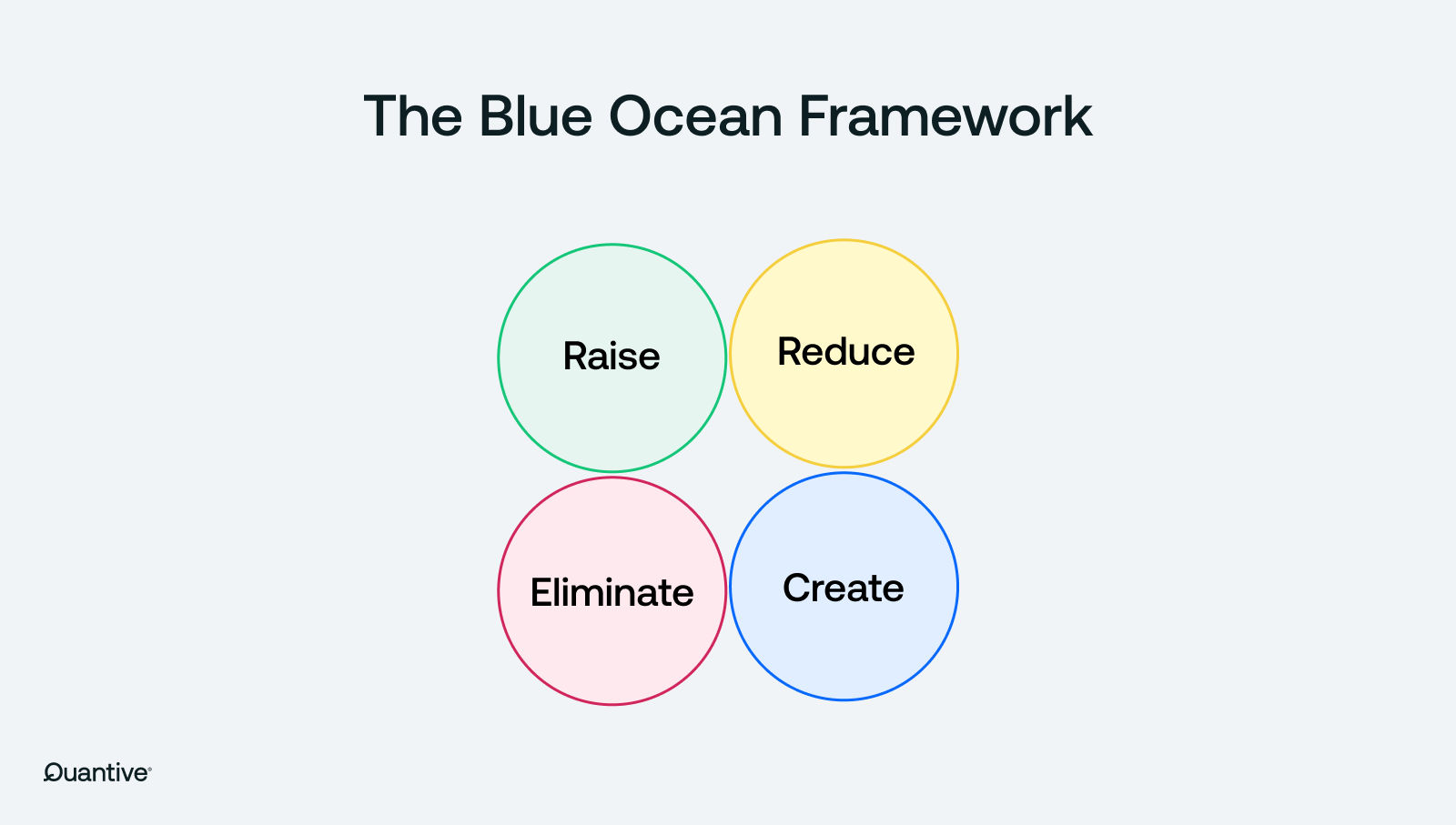Quantive is now part of WorkBoard. Get to know WorkBoard:
When markets are saturated and competition is dense, discovering new growth opportunities can seem impossible. Blue Ocean Strategy provides a dynamic framework for businesses to carve out new market spaces, encourage innovation, and achieve sustainable growth by making the competition irrelevant.
In this article, we'll provide an overview of the Blue Ocean Strategy framework, covering its:
- Definition
- Elements
- Origins
- Use cases
- Example
- Steps
- Benefits
What is the Blue Ocean Strategy?
Blue Ocean Strategy challenges the traditional focus on competing within existing industries (red oceans). Instead, it proposes creating an entirely new market space (blue oceans) where competition is irrelevant and demand is created. This framework helps businesses innovate and pursue untapped opportunities that differentiate them from competitors.
To better understand what the Blue Ocean Strategy is and how it differentiates from the Red Ocean Strategy, let's look at its core components and its application.
Blue Ocean Strategy vs. Red Ocean Strategy
Blue Ocean Strategy focuses on creating new market spaces, or "blue oceans," where competition is irrelevant because the rules are yet to be set. It involves innovation and unique value propositions to capture new demand, aiming for sustainable growth by differentiating and reducing costs simultaneously.
In contrast, the Red Ocean Strategy operates within existing markets, where companies compete to capture more of the existing demand, leading to intense competition, price wars, and shrinking profit margins. Red Ocean Strategy emphasizes incremental improvements and outcompeting rivals, while Blue Ocean Strategy seeks to create new opportunities and tap into unexplored markets for significant and lasting success.
What are the core components of Blue Ocean Strategy?
You can use several key frameworks and tools based on the Blue Ocean Strategy. Here's a quick intro to some of the main ones:
- Value innovation framework: This is the cornerstone of the Blue Ocean Strategy. The Blue Ocean Strategy argues that the simultaneous pursuit of differentiation and low cost to create new value for both the company and its customers.
- Eliminate-Reduce-Raise-Create (ERRC) Grid: This tool helps companies systematically identify and adjust factors to achieve value innovation and avoid a shrinking profit pool.
- Strategy Canvas: A diagnostic and action framework that captures the current state of play in the market and helps identify areas where a company can differentiate itself from competitors.
- Four Actions Framework: A tool that helps businesses reconstruct buyer value elements to discover how to eliminate, reduce, raise, and create features to unlock a new value curve.
- Six Paths Framework: Guides companies to explore new market spaces by examining alternative industries, strategic groups, buyer groups, complementary products, functional-emotional orientation, and time. This helps companies with breaking past industry boundaries to continue innovation.

Who developed the Blue Ocean Strategy?
W. Chan Kim and Renée Mauborgne, both INSEAD professors and leading thinkers in strategic management, introduced the Blue Ocean Strategy framework in their 2005 book, "Blue Ocean Strategy: How to Create Uncontested Market Space and Make the Competition Irrelevant." The book has been translated into over 40 languages and has sold millions of copies, underscoring its global impact on business practices.
When to use the Blue Ocean Strategy?
Use Blue Ocean Strategy when:
- Your industry is highly competitive with shrinking margins: Blue Ocean Strategy helps you find new market spaces with less competition.
- You want to break away from the competition and create new value propositions: It enables you to innovate and differentiate your offerings.
- You're looking for innovative ways to expand your customer base and drive growth: The strategy focuses on creating new demand and reaching untapped markets.
Blue Ocean Strategy example: Netflix and User-driven AI-powered content creation
Imagine that Netflix is considering using AI to create unique-to-the-viewer, on-demand entertainment experiences. Viewers could provide a few mood prompts and their viewing preferences, and AI would generate an animated movie or TV series tailored just for them.
Below's how the Blue Ocean Strategy can help Netflix navigate this potential.
Using Strategy Canvas, Netflix first analyzes the current streaming market, identifying key competitive factors such as content variety, user interface, subscription cost, and personalized recommendations. This helps them understand their position in the existing market.
Then, using the Eliminate-Reduce-Raise-Create (ERRC) Grid, Netflix determines to:
- Eliminate: Traditional content creation processes and the risk of viewers losing interest in pre-made content.
- Reduce: Reliance on established scriptwriters and directors, potentially lowering production costs.
- Raise: Customer satisfaction and engagement by providing highly tailored and engaging entertainment experiences.
- Create: An entirely new category of entertainment - personalized, AI-generated content.
After this, Netflix explores new market spaces using the Six Paths Framework, examining industries like video gaming and social media to see how they engage users and create interactive experiences. It then applies similar strategies to the streaming market.
Netflix then tests the AI-generated content with potential users through market research, focus groups, and pilot programs. This helps gather feedback and refine the offering to ensure it resonates with the target audience and has strong market traction.
How to make a blue ocean shift within your organization
Here’s a step-by-step guide to help you get started with the Blue Ocean Strategy.
Step 1: Define your current market space
Analyze your industry structure and competitor offerings using the Strategy Canvas to understand the current market landscape. Identify key factors of competition and assess how your offerings compare. Plot these factors on the Strategy Canvas to visualize your current position.
Step 2: Identify opportunities for differentiation
Apply the Eliminate-Reduce-Raise-Create (ERRC) Grid to explore ways to improve your value proposition by breaking away from industry norms. Determine which factors to eliminate, reduce, raise, or create to offer a unique value proposition that differentiates you from competitors.
Step 3: Explore potential Blue Oceans
Use the Six Paths Framework to identify unmet customer needs and create new market space. Explore alternative industries, strategic groups, buyer groups, complementary products, functional-emotional orientation, and time to discover innovative opportunities.
Step 4: Validate your Blue Ocean Strategy
Test your ideas with potential customers to ensure market traction and refine your strategy based on feedback. Conduct market research, focus groups, and pilot programs to validate the demand for your innovative offerings and gather insights for refinement.
Benefits of using Blue Ocean Strategy
A well-executed Blue Ocean Strategy offers numerous advantages for businesses seeking to innovate and grow:
- Competitive advantage: By creating uncontested market space, businesses can reduce competition and achieve a strong market position while breaking past market boundaries.
- Greater customer value: Increasing customer satisfaction by meeting unmet needs with unique offerings.
- Cost-effectiveness: Simultaneously reducing costs by eliminating or reducing less valuable factors.
- Market expansion: Opening new customer segments and expanding market reach, driving growth and profitability.
Using Quantive StrategyAI to explore a Blue Ocean Strategy
Quantive StrategyAI can empower you to create a your own blue oceans with the Blue Ocean Strategy. Provided with the right information, Quantive StrategyAI can help you:
- Analyze vast amounts of data to identify customer needs and unmet demands.
- Visualize potential blue oceans using advanced data analysis tools.
- Pressure-test and refine your Blue Ocean strategy through simulations and market research.
The experience is like having a strategic advisor at your side, guiding you through the Blue Ocean process in a fraction of the time it would normally take you. With comprehensive and timely strategic analysis you can then unlock uncontested market space and business potential by creating blue oceans with ease.
Quantive empowers modern organizations to turn their ambitions into reality through strategic agility. It's where strategy, teams, and data come together to drive effective decision-making, streamline execution, and maximize performance.
As your company navigates today’s competitive landscape, you need an Always-On Strategy to continuously bridge the gap between current and desired business outcomes. Quantive brings together the technology, expertise, and passion to transform your strategy and playbooks from a static formulation to a feedback-driven engine for growth.
Whether you’re a fast-growing scale-up, a mid-market business looking to conquer, or a large enterprise looking for innovation, Quantive keeps you ahead – every step of the way. For more information, visit www.quantive.com.





